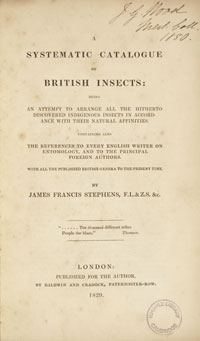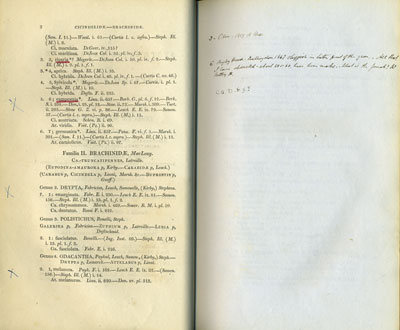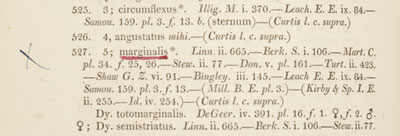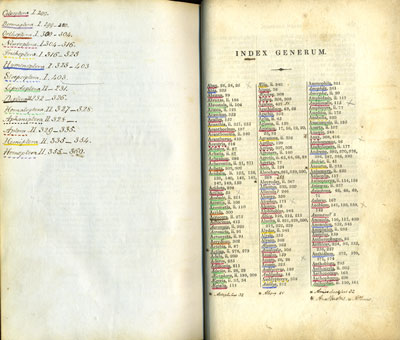James Francis Stephens (1792–1852), A Systematic Catalogue of British Insects: Being an Attempt to Arrange All the Hitherto Discovered Indigenous Insects in Accordance with Their Natural Affinities (London, 1829), with annotations by the famous naturalist J.G. Wood.
This is a unique copy of a major early 19th-century work on taxonomic listing, intended to include all known insects of the British Isles. Although a clerk at the Admiralty Office for his entire working career, James Francis Stephens cultivated from childhood a profound interest and knowledge in natural sciences. This is evidenced in the vast collection of insects he amassed, his several important published works on entomology, and his election as a fellow of the Linnean Society in 1815, and of the Zoological Society in 1826.
In 1818, at the request of the trustees of the British Museum, Stephens had been granted leave from the Admiralty to assist the naturalist William Elford Leach (1790–1836) in arranging the museum's insect collection, a project which paved the way for publication of this catalogue. Based largely on Stephens' own collection (which he subsequently left to the British Museum) the catalogue represented a significant advance on previous attempts to catalogue British insects. The Stephens proudly stated in his introduction:
As less than four thousand species have hitherto been recorded by name, by all preceding English writers, to inhabit Britain, and nearly ten thousand are named in the following pages, the fact of my having more than doubled the number sufficiently evinces the exertions I have made to attain perfection.1
Click on the images to enlarge
The Catalogue of British Insects was intended to supplement the first part of Stephens's chief work, Illustrations of British Entomology (1828–46), and to 'meet the wishes of several entomological friends, who have repeatedly solicited me to furnish them with arrangement of all our indigenous insects'.2
Each species has a number (from 1 to 100012) and entries are categorised into Ordo, Familia, and Genus. We can also see here how, where applicable, reference is made to the work of earlier entomologists upon which Stephens was seeking to build, including Linnaeus, Curtis, Faber, Panzer, Kirby, Marsh and others.
An asterisk indicates a species captured within 25 miles of St Paul's, London.
Reverend John George Wood (1827–1889)
The uniqueness of this copy owes to the fact that it contains numerous annotations by the famous populariser of science J.G. Wood who in 1850 became the owner of it (see Wood's signature on the top right hand corner of the title page, as well as reference to his Oxford college, Merton). A prolific publisher of books on natural history, Wood is a key figure in the 19th-century history of natural science for having brought a knowledge and appreciation of the subject to a mass audience. J.G. Wood is also of specific relevance to the Whipple Library on account of its extensive collection of his publications (see the Whipple Nineteenth Century Collections page).
This two volume book is thus of particular significance for the way that Wood's annotations reveal the research practices of this famous naturalist in action.
One can see how Wood annotated Stephens' catalogue in the page shown above. Throughout the two volumes, opposite Stephens' entries Wood indicated where he himself had seen the same specimens, sometimes including further comments and referring to his own publications. Mostly Wood documents specimens located in the vicinity of his home town, Oxford. For example, against specimen no. 6 'Germanica' (a type of beetle – see page above) Wood has written where he found this insect with the following comments: 'Bayley Wood. Bullingdon 1847 sluggish in later part of the year. All that I have dissected – about 50 or 60, have been males. What is the female?: W'
On p. 52 against species no. 527, (the 'marginalis' or great diving beetle), Wood states that he found these on 'ditches round the meadows in profusion. I kept moving, but they always sallied and ate each other, instead of the sweat that was given them. They always began at the opening of the cloaca. W.'
The index to the volume provides further indications of Wood's working practices. Here different colours are assigned to different categories of insect thereby facilitating use of index.
These are just some of the ways in which this two volume book is important, not just as a copy of James Stephens' Catalogue of British Insects, but also for the way it reveals the working methods of an important figure in the history of 19th-century science. In this we see the value of old books as a record of past practices and as a means of better understanding the history of science.
Other published works of Stephens
- The nomenclature of British insects : being a compendious list of such species as are contained in the systematic catalogue of British insects, and forming a guide to their classification, &c. &c. (London, 1829)
- A manual of British Coleoptera, or beetles : containing a brief description of all the species of beetles hitherto ascertained to inhabit Great Britain and Ireland; together with a notice of their chief localities, times and places of appearances, etc (London, 1839)
- Illustrations of British Entomology, or a Synopsis of indigenous insects : containing their generic and specific distinctions, with an account of their metamorphoses, times of appearance, localities, food, and economy, as far as practicable. Embellished with coloured figures of the rarer and more interesting species (London, 1828–46)
- The last six volumes of: General zoology, or, Systematic natural history / by George Shaw. With plates from the first authorities and most select specimens, engraved principally by Mr. Heath (London, 1800–26)
References
1 Stephens, p. xvii.
2 Ibid., p. iii.






